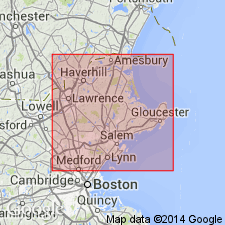
- Usage in publication:
-
- Beverly syenites
- Modifications:
-
- First used
- Dominant lithology:
-
- Syenite
- AAPG geologic province:
-
- New England province
Summary:
Used the name Beverly syenites for rocks confined to contact zone of the Cape Ann and Peabody batholiths. Syenites range from quartz syenite or nordmarkites through alkaline syenites, pulaskites, and umptekites, to nephelite syenites. The syenites occur as small irregular intrusive masses and dikes. Age is considered late(?) Paleozoic.
Source: GNU records (USGS DDS-6; Reston GNULEX).
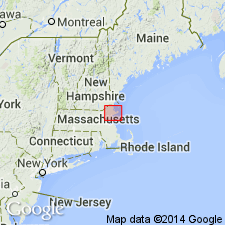
- Usage in publication:
-
- Beverly syenite*
- Modifications:
-
- Named
- Dominant lithology:
-
- Syenite
- AAPG geologic province:
-
- New England province
Summary:
Beverly syenite is applied to microperthite syenite, pulaskite, or umptekite in Essex Co., MA. Considered of Carboniferous age. Unit is bounded by the Dedham granodiorite of Devonian(?) age and the Quincy granite of Carboniferous age. The syenitic rocks are confined to the contact zone of the batholith and are probably marginal variations of the alkaline batholith.
Source: GNU records (USGS DDS-6; Reston GNULEX).
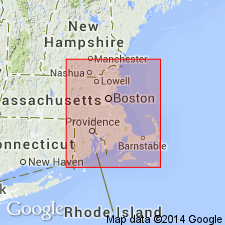
- Usage in publication:
-
- Beverly Syenite*
- Modifications:
-
- Age modified
- Revised
- AAPG geologic province:
-
- New England province
Summary:
Age changed from late(?) Paleozoic to Late Ordovician or Early Silurian (see remarks from Zartman and Marvin, 1971, with the Cape Ann record). Considered as a facies of the Cape Ann Complex.
Source: GNU records (USGS DDS-6; Reston GNULEX).

- Usage in publication:
-
- Beverly Syenite*
- Modifications:
-
- Overview
- AAPG geologic province:
-
- New England province
Summary:
Used as Beverly Syenite, a quartz-poor facies of Cape Ann Complex. Age is Late Ordovician or Early Silurian.
Source: GNU records (USGS DDS-6; Reston GNULEX).
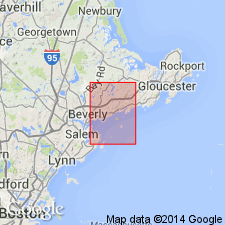
- Usage in publication:
-
- Beverly†
- Modifications:
-
- Abandoned
- AAPG geologic province:
-
- New England province
Summary:
Cape Ann Complex of Goldsmith and others (1982) and used on the Massachusetts State Geologic Map (Zen and others, 1983) is revised and renamed the Cape Ann Granite. The name is changed primarily because this rock assemblage does not fit the definition of a complex as defined in the North American Stratigraphic Code (1983). The new definition includes the original Cape Ann Granite (Toulmin, 1964) and the Beverly syenite of Washington (1898, 1899) and Clapp (1910). The use of Cape Ann Complex, which includes the original Cape Ann Granite, the Squam Granite of Clapp (1910), and the Beverly Syenite, is discontinued. The Beverly Syenite is considered a facies of the Cape Ann Granite and effectively abandoned as a formal unit.
Source: GNU records (USGS DDS-6; Reston GNULEX).
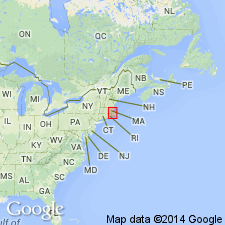
- Usage in publication:
-
- Beverly Syenite*
- Modifications:
-
- Overview
- AAPG geologic province:
-
- New England province
Summary:
Beverly Syenite is part of Cape Ann Complex. Forms subordinate elongate masses within main mass of Cape Ann; dikes of syenite also intrude gabbro at Salem Neck, as well as elsewhere in the Salem area, suggesting that Beverly is, at least in part, a differentiate. Described as cream colored, medium to coarse grained, and rich in alkali feldspar. Age is Late Ordovician and Early Silurian. [Papers presented as chapters in U.S. Geological Survey Professional Paper 1366 are intended as explanations and (or) revisions to MA State bedrock geologic map of Zen and others (1983) at scale of 1:250,000.]
Source: GNU records (USGS DDS-6; Reston GNULEX).
For more information, please contact Nancy Stamm, Geologic Names Committee Secretary.
Asterisk (*) indicates published by U.S. Geological Survey authors.
"No current usage" (†) implies that a name has been abandoned or has fallen into disuse. Former usage and, if known, replacement name given in parentheses ( ).
Slash (/) indicates name conflicts with nomenclatural guidelines (CSN, 1933; ACSN, 1961, 1970; NACSN, 1983, 2005, 2021). May be explained within brackets ([ ]).

